

Where does Penang Hokkien come from?
 Go Back - Latest PENANG Sights/Streets/New Properties > Malaysia > World | Hokkien : Lessons : Dictionary | YouTube | Facebook | About Me : Contact Me
Go Back - Latest PENANG Sights/Streets/New Properties > Malaysia > World | Hokkien : Lessons : Dictionary | YouTube | Facebook | About Me : Contact Me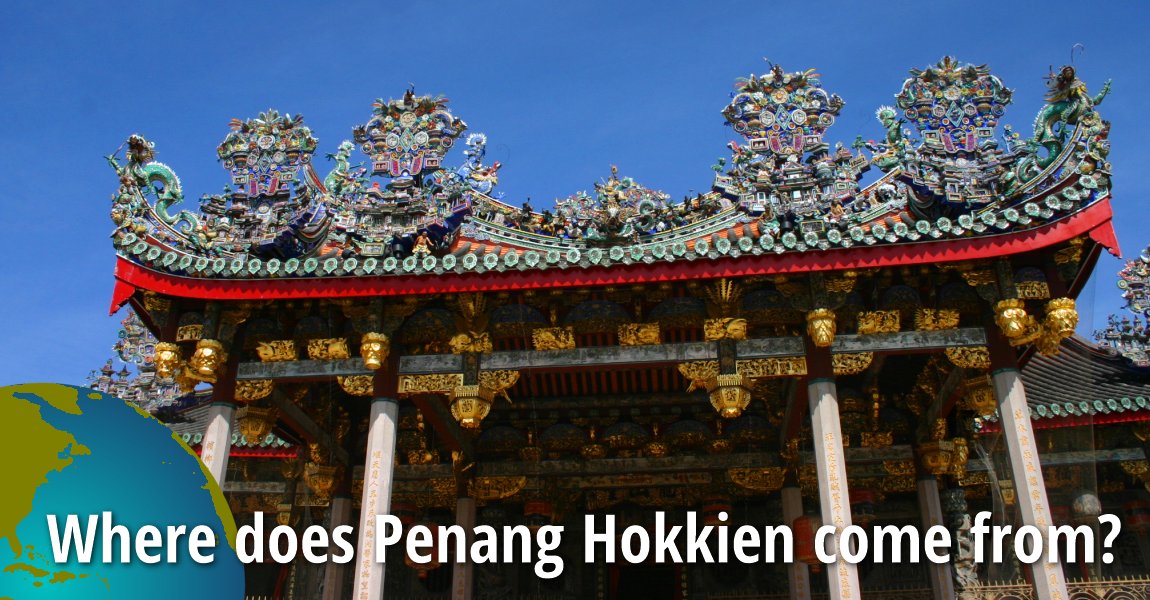 Where does Penang Hokkien come from? (5 February 2017)
Where does Penang Hokkien come from? (5 February 2017)
Where does Penang Hokkien come from? Why do the Chinese people of Penang speak this language? When do they start speaking this language? Why do they choose to speak Penang Hokkien?
A lot of people, including many Penang Chinese themselves, do not know the answer. In my opinion, many books on Penang have not given the right answer either.
Based on the research I have carried out, I have formed a hypothesis that I am now sharing with you. I call this a hypothesis because it is based on evidence I have accumulated, but it is not complete enough for me to declare it as fact. Nonetheless, it provides the most reasonable explanation for the origin of Penang Hokkien. After reading this article, please also read Arrivals of the Chinese in the Malay peninsula.
According to popular belief, the Hokkiens originated from seafarers who came to this part of the world to trade, from the 16th century and even earlier. Although Hokkien seafarers did visit this region, and did play an important part helping Hokkien gain a foothold in this region, I believe they were not the ancestors of the Penang Hokkien.
Today the Penang Chinese speak a form of Hokkien that has many loan words borrowed from Malay. They have also adopted elements from local cuisine, dressing and beliefs, incorporating it into our own (which contemporarily is known as Baba Nyonya culture).
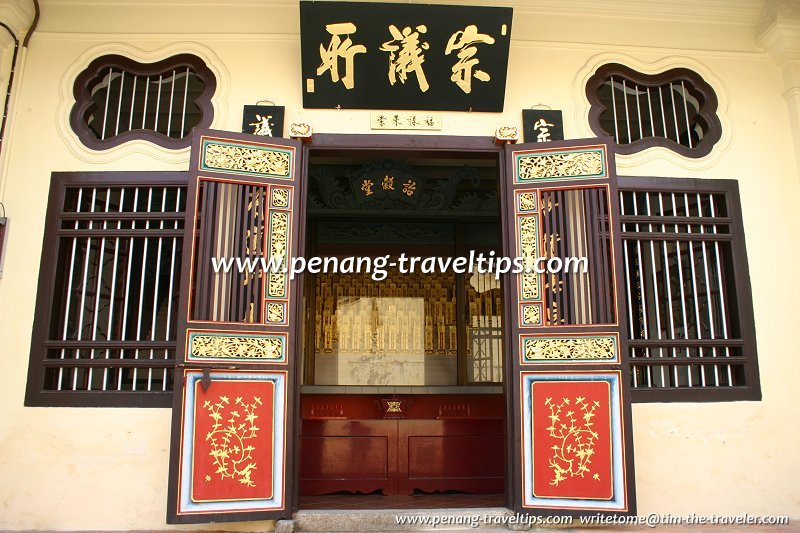 Khoo Kongsi (28 February 2004)
Khoo Kongsi (28 February 2004)
For them to borrow the customs, dressing and cuisine from outside their community, only as and when they deem necessary, yet retain the use of their Hokkien language, they must have been substantially numerous, that they are able to keep among themselves, putting outsiders at bay, and interact with the local community only when they choose to do so. If they were few to begin, they would have been absorbed into the local community long ago.
Furthermore, if they were all men, as seafaring merchants were, they would have married the local women, who would speak to their offsprings in the local language, resulting in Baba Malay, which is the product of 15th century Fujian merchants and local women during the Malacca Sultanate. The father figure would be moving about from one port to the other, and would not be stationed in one spot long enough to pass down his language to his own children. That's what happened to the Chinese Peranakan of Malacca, which explains why the Peranakan of Malacca speak Malay with the inclusion of words in Chinese, and when we say in Chinese, we mean in Hokkien.
In Penang, the reverse is true. The Baba Nyonya of Penang speak Hokkien (that's Penang Hokkien) with the inclusion of Malay words. In order for the next and subsequent generation to retain the Hokkien mother tongue, the Hokkien-speaking mothers have to be around. In other words, in order for Hokkien to take root in this region, something massive must have taken place in China that brought an influx, not only of men, but men, women, children and even livestock.
For example, the Chinese eat pork. Pork that comes from domesticated pigs, not wildboars from the jungle. Where do domesticated pigs come from, if the other peoples of substantial numbers - the Malays and the Indians - do not take pork? It must have been brought in.
In Hokkien there is a saying, tnui1 Tng3 Snua1. It means "go back to China". This is the purpose and final hope of the Chinese immigrants of the 19th century, to make it big, and then retire to a prosperous life in China. However, before Chinese immigrants arrived in large numbers in the 19th century, there was already an earlier group of Chinese who have settled in this region. By the time the newcomers arrived, this earlier group has established themselves. As most of them were living in the Straits Settlements, they became known as the Straits Chinese, whereas the newbies were called Sin3khek3, or "new guests" or "newcomers". Those who are not the Sinkhehs are called by various names including Straits Chinese, Baba Nyonya, or simply, Lau33khek3, meaning "old timers".
The term Straits Chinese is misleading, because it only describes the Chinese from the time the British established the Straits Settlements. In reality, the Chinese have been around since much earlier. Even before Captain Francis Light founded George Town, they were already living in estuary villages along the coasts, in places such as Prai, Kuala Muda, Kuala Kedah, Trang and Phuket in Thaland (then Siam). These places were the incubators for the development of Penang Hokkien, a place where the migrant Chinese interacted with the indigenous people, and in so doing began incorporating words into their language. After George Town was established, they relocated over, following the leathership of their headman, Koh Lay Huan. Most of them were Hokkien, and it was they who made Hokkien the lingua franca of the Chinese in Penang.
It should be noted though that Penang Hokkien pre-dates Penang. It was already spoken by the small pockets of Chinese people who were living in the region that is southern Siam even before the founding of Penang by Captain Francis Light.
Here, I should point out that Koh Lay Huan is a different kettle of fish from the men he led to Penang. They were born locally, in Kedah, which at various times in history, was either a vassal state or an annexed part of the Kingdom of Siam. He, on the other hand, was born in Zhangzhou, China. They were largely illiterate; he was a learned man with an established business knowledge. The reason he was in this part of the world, and not back home in China, was because of his involvement in the Heaven and Earth Society, the triad that attempted to overthrow the Manchu - something which a hundred years back, the forefathers of those locally born Chinese attempted and failed. History repeated itself, for Koh too failed to bring down the Qing government, and so he too had to flee China.
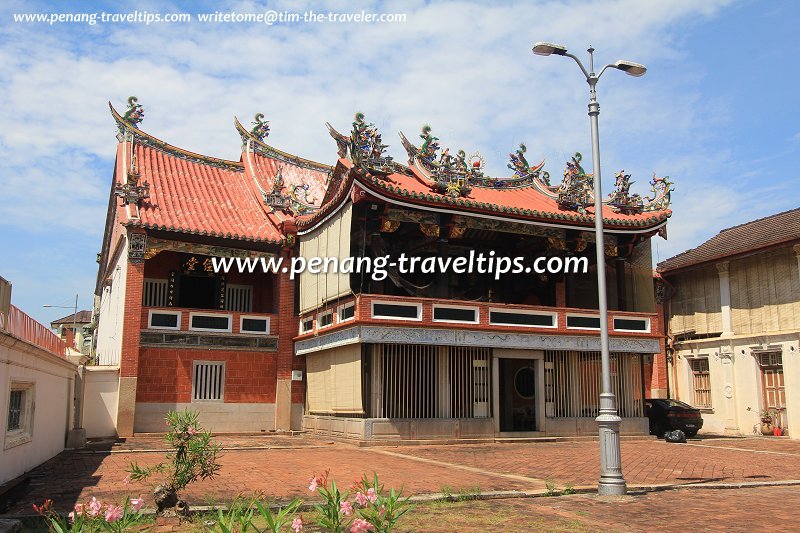 Yeoh Kongsi, one of the Hokkien clans in Penang (25 January 2013)
Yeoh Kongsi, one of the Hokkien clans in Penang (25 January 2013)
But when did these Hokkien people arrive in this region? And why did they uproot themselves from their homeland in Fujian Province, China, to resettle in a place so far away? If we study the Peranakan people spread across Southeast Asia, we will find many reasons. But for those who are the ancestors of the Penang Chinese, there was a single tumultuous event that "rocked their world", so to speak, forcing them to leave, severe their ties, and never turn back.
But before we look into the forefathers of Penang Hokkien, it is pertinent to acknowledge that Chinese seafarers, particularly from Fujian and Guangdong provinces, have made sundry visits to the Nanyang, going back to the Ming, Yuan and earlier dynasties of China. If they settled in this region at all, their numbers were so small that over time, they were absorbed into the indigenous community. In order for the Chinese to establish themselves, and to make their language, Hokkien, the lingua franca, they must have arrived in substantial numbers.
The Ming Dynasty was in decline since the beginning of the 17th century under constant siege from invasions staged by the Manchus, who eventually vanquished the Mings to establish the Qing Dynasty. The Manchus swept through China from north to south, conquering the country province by province. They arrived in Fujian Province in the mid-17th century, where they met with fierce resistance from Zheng Chenggong (Koxinga). By then the last Ming emperor had committed suicide (after having killed off the immediate members of the imperial household), but Koxinga continued to pledge allegiance to the last remaining claimant of the Ming throne.
There were several battles in Fujian Province between troops of the newly installed Qing government and the Ming loyalist rebels. This resulted in a series of massacres in Zhangzhou, in 1651 and 1652. Eventually the Ming loyalists were defeated, and they fled to Taiwan. To prevent the locals from offering help to the Ming loyalists, the Manchus forced the relocation of the population away from the Fujian coast.
Based on research thus far carried out, I have reason to believe that Penang Hokkien was brought over by refugees fleeing Fujian Province during the period between the Ming and Qing dynasties. To be precise, between 1644 until 1682, when Taiwan was incorporated as a prefecture of Fujian province, and the policy to clearing the coast rescinded, the ancestors of the Penang Chinese people must have fled Fujian province.
Whether or not the early Hokkien settlers included Ming loyalists, I do not know, but I believe the Zhangzhou massacre was the reason they fled China. Either that, or the decree to move them inland. As Penang Hokkien bears much resemblance to Zhangzhou Hokkien, that provides me the clue that the earliest Hokkien forefathers came from Zhangzhou and counties in its surrounding areas.
In my opinion, the earliest settlers were therefore not seafarers (as in sailors), but rather a diaspora comprising refugees who either fought to defend Fujian, and fled when they lost the fight against the invading Manchus; or, they were simply running for their lives to avoid bloodshed. At that time, there was in fact an established network of sea routes controlled by Hokkien merchants (and pirates), and these refugees probably took advantage of the seafaring knowledge of their merchantile cousins to get as far away from Fujian province as it is possible for them to. Unlike the later Sinkheks, there was no compulsion to tnui1 Tng3 Snua1 for them. They probably knew quite well that the Qing Dynasty was there to stay - at least within their lifetime - and going home would spell certain death.
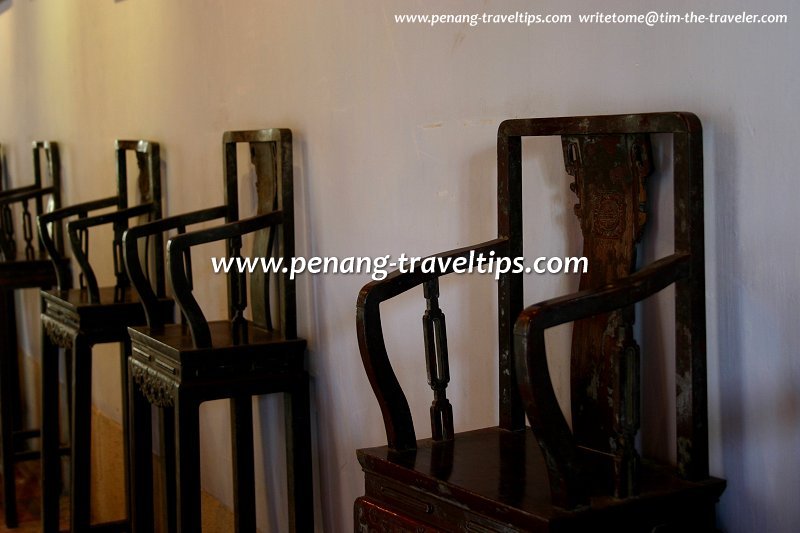 Wooden chairs at Khoo Kongsi (28 February 2004)
Wooden chairs at Khoo Kongsi (28 February 2004)
The collapse of the Ming Dynasty caused a Hokkien diaspora to be scattered throughout Southeast Asia. While they are the main group of refugees, Manchu invasion also affected the Hakkas, Teochews and the Cantonese who similarly had to flee. I believe the mass exodus of the Hokkiens was carried out in a flotilla of many boats, for better protection.
Hokkiens (and Teochews) from different cities in Fujian Province fled during different times, and they ended up in different parts of Southeast Asia. The Nanyang was a broad region that spreads from the Philippines to Myanmar, and these Hokkien refugees established pockets of settlements. Those from around Zhangzhou ended up on the northern coast of the Malay peninsula, and they planted the seed for the Chinese communities there. When George Town was established, they relocated there and became the predominant Chinese ethnic group. In their new homeland, they engaged in farming and mining (anything from tin to bauxite to gold), and those in the towns became merchants and traders. By the 19th century, they were in control of most of the businesses in the Nanyang, whether it is in Manila or Bangkok or George Town or Yangon.
When large-scale tin mining was carried out in Larut region, the descendants of the Hokkiens now living in George Town invested heavily in the industry, and in so doing, planted Hokkien as the lingua franca of the Chinese in Taiping. That was the one and only major tin-mining town in the Malay peninsula to use Hokkien, as towns after that, located further down the peninsula took on Cantonese as the lingua franca.
The original Hokkien settlers must have been quite substantial in numbers in order to preserve and retain the syntext of their language. The contingent included not only men, but men, women, children and livestock such as chicken, ducks and pigs. It was wholesale displacement. If they were few in numbers, they would have completely assimilated to the native community. However, up to today, there are some resemblance between Penang Hokkien and the Hokkien spoken in China.
Considering the Hokkien spoken in different parts of the peninsula differ, the original settlers must have come out from different cities in Fujian province. The original settlers of the northern coast of the peninsula came from Zhangzhou and its whereabouts, whereas those on the southern coast came from Quanzhou, Xiamen and their whereabouts.
View Voyage of the Hokkien refugees into the Nanyang in a larger map
In the initial stage, the Hokkien settlers were entirely cut off from homeland China. There was no way to go back to China, where the Qing rulers held power with an iron fist, and the price of returning would be death in the most terrible way.
So the Hokkien refugees had to make a new life in their adopted homeland. Life must have been tough in the beginning, but they adapted, and over time, they began to accept local words, customs, food and dressing. Local words found their way into their Hokkien language largely because they have forgotten the word in their native tongue, or were only encountering them in their new homeland. And that was how words like ba1tu2, sa1bun2 and jam1ban2 crept into Penang Hokkien.
I should point out here that the majority of the refugees were illiterate. They speak the vernacular which corresponds to the colloquial reading of Hokkien. As such, most of the words in Penang Hokkien are from the colloquial register. Most speakers of Penang Hokkien could not explain why, for example, the word for dragon can be both "leng2" as well as "leong2", or why cardinal number two is nor33 while the ordinal is jee33. Their language underwent an incubation period when it lost much of its literary register.
Over time, the original settlers passed away, and their offsprings of subsequent generations became known as the Penang Peranakan, or Penang Baba Nyonya. As the original refugees include many from the largely illiterate class, they were unable to document the history of their arrival. However, they play a crucial role in establishing the infrastructure, so that when the door of China reopen for merchantile trade, and trading between China and the Nanyang resumed, that infrastructure enabled the merchant class to easily establish themselves in the major port cities, including Penang. Unlike the earlier arrivals, the merchantile class are a literate people with business acumen. Unlike the people before them, they could read, write and document their history. They were able to form merchantile guilds to protect their interest and that of their clansmen.
Having turned their backs on China, the Penang Baba Nyonyas looked west, to the British, sending their children to schools established by the British administrators and missionaries. These children became the "banana people" of the 19th century, anglophiles who were Chinese on the outside, but British to the core. Although they maintained their culture, religion and beliefs, many particularly the men were English educated.
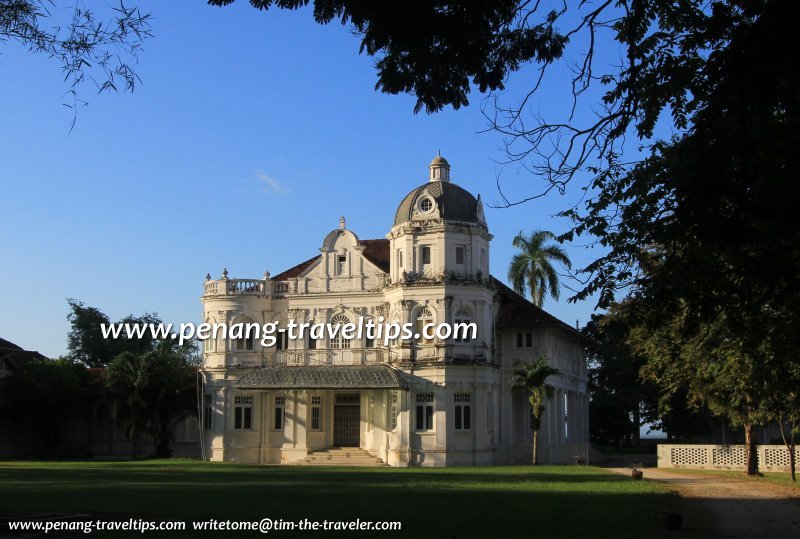 Woodville, a reflection of the Anglophile stance of the affluent Penang Chinese (5 August 2012)
Woodville, a reflection of the Anglophile stance of the affluent Penang Chinese (5 August 2012)
As the generations passed, the Qing rulers eventually relaxed travel restrictions, and seafarers were once more able to leave Fujian and Guangdong provinces. These seafarers re-established the ties between homeland China and the Nanyang, and between the Penang Baba Nyonyas and their ancestral homeland.
There is marked disparity between the Penang Baba Nyonyas and the Chinaman, usually with the former being the "haves" and the latter being the "have-nots". To marry into the Penang Baba Nyonya community, a Chinaman (now it's always men, rarely women) has to prove that he is uh3 liau3 (a person "of substance"). The Penang Baba Nyonyas will also take main wives from among themselves, though lesser wives and concubines may come from the servant class, which included slave girls from Sumatra.
The Taiping rebellion in China (1850-1864) and other similar rebellions erupting all over China in the 19th century severely weakened Qing rule. As with the Manchu invasion of the 17th century, the rebellions of the 19th century also brought great hardship to the people of Fujian and Guangdong province. This coincided with the start of large-scale tin mining in Malaya, with the first main tin mines being at Larut.
To work the mine fields, Hokkien investors in Penang brought coolies over from China. Most of them arrive here as penniless indenture labourers. The process usually entailed home village functioning as "employment agency" in signing up workers according to clan. The whole process is managed by the clan associations, many of which exist till this day, albeit having evolved away from their original role.
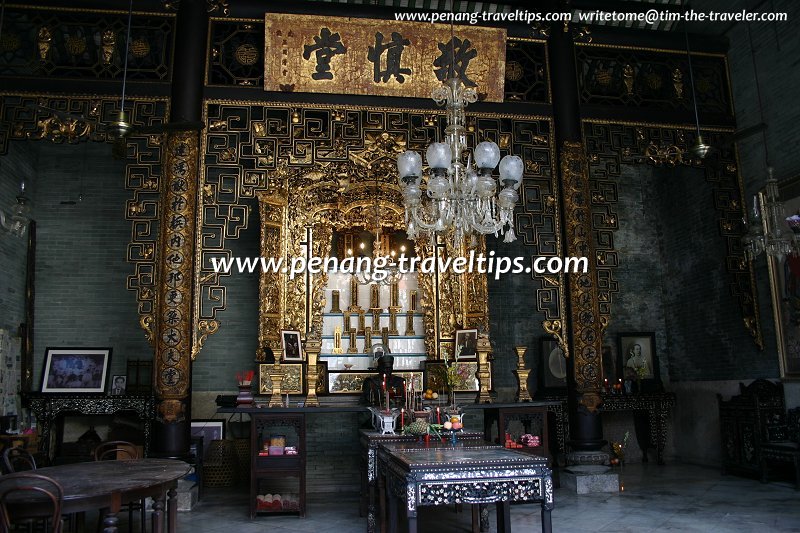 Ancestral Temple of Kapitan Cina Chung Keng Kwee, who is himself a Sinkhek (30 October 2004)
Ancestral Temple of Kapitan Cina Chung Keng Kwee, who is himself a Sinkhek (30 October 2004)
Unlike the Penang Baba Nyonyas, the penniless workers had a clear desire to tnui1 Tng3 Snua1, though this is easier said than done. The Sinkhek began trickling into Penang in the mid 19th century, but as the decades passed, their numbers rapidly swelled. Within a span of ten years, between 1880 and 1890, the Chinese population of Penang more than doubled, with the Sinkheks greatly outnumbering the Baba Nyonyas.
Some of the Sinkheks made it big, among them Cheong Fatt Tze, Chung Keng Kwee and Yeap Chor Ee. All of them made Penang their new home. Although being Sinkhek, they also adopted the customs of the Penang Baba Nyonyas, though to be precise, it is more accurate to describe them as "upper-crust affluent Chinese".
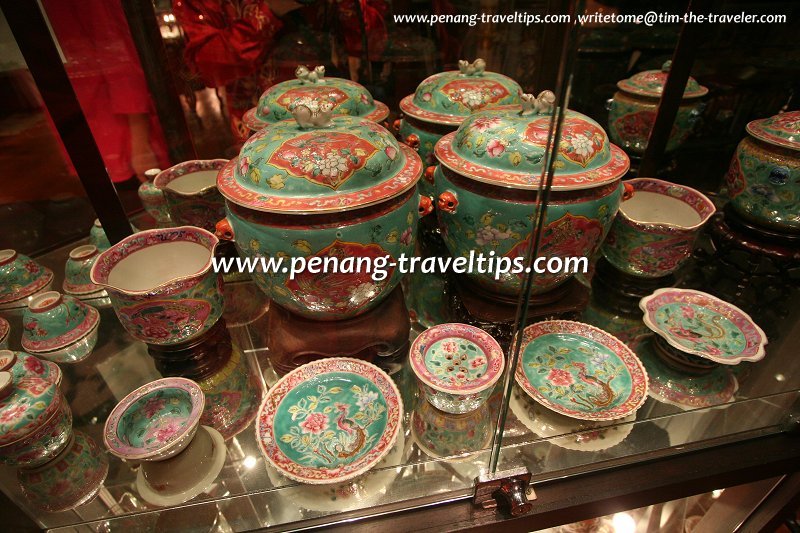 Nyonya porcelain, though used by the affluent Baba Nyonyas, were mostly made in China (8 October 2009)
Nyonya porcelain, though used by the affluent Baba Nyonyas, were mostly made in China (8 October 2009)
During the golden years of tin mining, the medium of instruction for the Chinese children were either English or the local Chinese languages such as Hokkien and Teochew. If they are taught in Hokkien or Teochew, what it means is that the students learned to read Literary Chinese which they pronounced in the literary reading of their own language. For Hokkien, that would be the literary reading of Hokkien, which is often different from everyday Hokkien. Many of the Chinese schools in Penang such as the Penang Chinese Girls High School and Han Chiang High School originally taught in these languages.
The use of Mandarin as medium of instruction among Chinese children began only in the early 20th century, particularly after exposure to Dr Sun Yat Sen, culminating with the Chinese Revolution that ended Qing rule. For much of the 19th century, most Penang Baba Nyonyas continued to "Look West", sending their children to English schools, whereas the Sinkheks largely sent theirs to Chinese schools.
In the 1970s, a change in the Malaysian education system nationalizing the English schools and mission schools brought a seismic shift in education focus for many Penang Chinese families. With the English medium of instruction being done away, they now send their children to Chinese schools. At the same time, the Penang Baba Nyonyas also suffered an erosion in their culture and the blurring of lines between the Baba Nyonyas and the Sinkheks.
The Chinese in Penang are today more homogenous than before. The majority now speak Mandarin, the result of their Mandarin education. However, since the late 20th century and at the turn of the 21st, particularly following and as a result of the inscription of George Town as a World Heritage Site, there is now a rejuvenation of interest in things heritage. The ability to speak Penang Hokkien, once considered archaic, is now regaining popularity, as the people of Penang realise that this is an intangible heritage that is unique to this region and that it should not be lost.
At Penang Travel Tips, I am working to help bring back Penang Hokkien with a series of lessons to help people learn the language. The lessons are geared not only to the local Chinese, but also to anybody interested to learn Penang Hokkien, including tourists, visitors, expatriates and Malaysians of other faces. To follow the lessons, go to Learn Penang Hokkien and be a member of the Learn Penang Hokkien Facebook Group.
Wikipedia References
Bibliography
- Coxinga and the Fall of the Ming Dynasty, by Jonathan Clements
- The Origin of Chinese Kongsi by Wang Tai Peng, Pelanduk Publications
- Penang: Rites of Belonging in a Malaysian Chinese Community, by Jean Elizabeth DeBernardi, NUS Press, 2009
- The Rise of Merchant Empires: LOng Distance Trade in the Early Modern World, by James D. Tracy, Cambridge University Press, page 405
- Connecting and Distancing: Southeast Asia and China, by Ho Khai Leong, Institute of Southeast Asian Studies, 2009, page 11
- Sojourners and Settlers: Histories of Southeast Asia and the Chinese, edited by Anthony Reid, University of Hawaii Press, 2001
- The Chinese Diaspora: Space, Place, Mobility and Identity, edited by Laurence J.C. Ma & Carolyn L, Cartier, Rowman & Littlefield Publishers, Inc., 2003
Learn Penang Hokkien with Memrise
Now you can use the most user-friendly tool on the web to learn Penang Hokkien. It helps you to listen, understand and memorise. Go to Memrise, and learn Penang Hokkien at your own pace. [an error occurred while processing this directive]
[an error occurred while processing this directive] Buy, rent or sell properties in Penang
Buy, rent or sell properties in Penang
Do you have a property for sale or to rent out? Are you looking to buy or rent a property? Get in touch with me. WhatsApp me (Timothy Tye) at 012 429 9844, and I will assign one of my property agents to serve you. I will choose the agent for you, according to your property needs. So when you message me, provide me some details of what you need, whether to sell, to buy, to rent or to rent out, and what type of property, is it condo, apartment, house, shop, office or land.Adakah anda mempunyai hartanah untuk dijual atau disewakan? Adakah anda ingin membeli atau menyewa hartanah? Hubungi saya. WhatsApp saya (Timothy Tye) di 012 429 9844, dan saya akan menugaskan salah seorang ejen hartanah saya untuk berkhidmat kepada anda. Saya akan pilih ejen untuk anda, mengikut keperluan hartanah anda. Oleh itu, apabila anda menghantar mesej kepada saya, berikan saya beberapa butiran tentang apa yang anda perlukan, sama ada untuk menjual, untuk membeli, untuk disewakan atau untuk disewakan, dan jenis hartanah apakah itu kondo, pangsapuri, rumah, kedai, pejabat atau tanah.
您有待出售或出租的房产吗? 您想购买或租赁房产吗? 与我联系。 WhatsApp 我 (Timothy Tye) 012 429 9844,我将指派一名房地产经纪人为您服务。 我会根据您的房产需求,为您选择代理。 因此,当您给我发消息时,请向我提供一些您需要的详细信息,无论是出售、购买、出租还是出租,以及房产类型,是公寓、公寓、房屋、商店、办公室还是土地。
 New Properties in Penang
New Properties in Penang
Looking to buy property in Penang? Get the e-brochures right here without having to visit or contact individual developers.- Anggun Residences E-Brochure, Batu Kawan
- Aston Acacia E-Brochure, Bukit Mertajam
- Beacon Executive Suites E-Brochure, George Town
- Beverly Heights @ Bukit Gambir E-Brochure, Gelugor
- BM Highland E-Brochure, Bukit Mertajam
- Cypress Villa E-Brochure, Sungai Ara
- D'Zone Condominium E-Brochure, Teluk Kumbar
- Elements Garden E-Brochure, Butterworth
- Ferringhi Residence 2 E-Brochure, Batu Ferringhi
- GEM Residences E-Brochure, Prai
- Golden Triangle 2 E-Brochure, Sungai Ara/Relau
- Grace Residence E-Brochure, Jelutong
- Granito @ Permai E-Brochure, Tanjong Bungah
- Green City Residence E-Brochure, Jelutong
- Havana Beach Residences E-Brochure, Bayan Lepas
- Imperial Residences E-Brochure, Sungai Ara/Relau
- Imperial Grande E-Brochure, Sungai Ara/Relau
- Lucerne Residence E-Brochure, Bayan Lepas
- Mezzo @ The Light City E-Brochure, Gelugor
- Middleton E-Brochure, Gelugor
- Orchard Villa 3 E-Brochure, Simpang Ampat
- Primero Heights E-Brochure, Permatang Pauh
- Queens Waterfront Q2 E-Brochure, Bayan Lepas
- Royale Heights @ Tambun Royale City E-Brochure, Simpang Ampat
- Royale Infinity @ Tambun Royale City E-Brochure, Simpang Ampat
- Rubica @ Harbour Place E-Brochure, Butterworth
- Sensasi Commercial Suites E-Brochure, Batu Kawan
- Setia Sky Ville E-Brochure, Jelutong
- Setia Sky Vista E-Brochure, Sungai Ara/Relau
- Setia V Residence E-Brochure, Gurney Drive
- Sinaran Residence E-Brochure, Batu Kawan
- Sky @ TriPark E-Brochure, Bukit Mertajam
- Skyridge Garden E-Brochure, Tanjong Tokong
- Starhill Luxury Residences E-Brochure, Gelugor
- Straits Residences E-Brochure, Tanjong Tokong
- Taman Nuri Emas E-Brochure, Nibong Tebal
- The Light Collection IV E-Brochure, Gelugor
- The Loft @ Southbay E-Brochure, Batu Maung
- The Terraces Condominium E-Brochure, Bukit Jambul
- Trehaus Condo Villas E-Brochure, Bukit Jambul
- Triuni Residences E-Brochure, Batu Uban
- Urban Suites E-Brochure, Tanjong Tokong
- Valencia Residence E-Brochure, Bayan Lepas
- Vertu Resort E-Brochure, Batu Kawan
- Vivo Executive Apartment E-Brochure, Batu Kawan
- Viluxe E-Brochure, Batu Kawan
- Waterside Residence E-Brochure, Gelugor
 Latest updates on Penang Travel Tips
Latest updates on Penang Travel Tips
 Discover with Timothy YouTube Channel
Discover with Timothy YouTube Channel
 PG Food Channel
PG Food Channel
 Learn Penang Hokkien YouTube Channel
Learn Penang Hokkien YouTube Channel
 SojiMart Videos
SojiMart Videos
 Share your travels and/or ask a travel-related question
Share your travels and/or ask a travel-related question
Join the Penang Travel Tips Facebook Group to share photos, tips and anything related to your travels, or ask travel-related questions.
 Map of Roads in Penang
Map of Roads in Penang
Looking for information on Penang? Use this Map of Roads in Penang to zoom in on information about Penang, brought to you road by road. Discover with Timothy
Discover with Timothy
Let me take you to explore and discover Penang through my series of walking tours on YouTube. You may use these videos as your virtual tour guide. At the beginning of each video, I provide the starting point coordinates which you may key into your GPS, Google Maps or Waze, to be navigated to where I start the walk, and use the video as your virtual tour guide.Disclaimer
Please use the information on this page as guidance only. The author endeavours to update the information on this page from time to time, but regrets any inaccuracies if there be any.Latest from Discover with Timothy: Gurney Bay - what to see and do there
About this website

Hello and thanks for reading this page. My name is Timothy and my hobby is in describing places so that I can share the information with the general public. My website has become the go to site for a lot of people including students, teachers, journalists, etc. whenever they seek information on places, particularly those in Malaysia and Singapore. I have been doing this since 5 January 2003, for over twenty years already. You can read about me at Discover Timothy. By now I have compiled information on thousands of places, mostly in Peninsular Malaysia and Singapore, and I continue to add more almost every day. My goal is to describe every street in every town in Malaysia and Singapore.
Robbie's Roadmap
- Episode 1: Robbie's Journey to Financial Freedom
- Episode 2: Lost in America
- Episode 3: The Value of Money
- Episode 4: The Mentor
- Episode 5: The Thing that Makes Money
- Episode 6: The walk with a Billionaire
- Episode 7: The Financial Freedom Awakening
- Episode 8: Meet Mr Washington
- Episode 9: The Pizzeria Incident
Copyright © 2003-2024 Timothy Tye. All Rights Reserved.